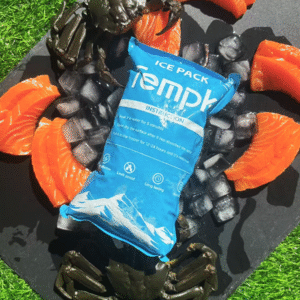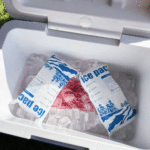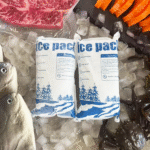How Do Frozen Food Dry Ice Packs Improve Cold Chain Shipping?
Ensuring the freshness and quality of frozen foods during transport is essential in the cold chain logistics industry. Dry ice packs serve as a reliable solution, providing consistent temperature control for long-distance shipments. In diesem Artikel, we’ll explore how frozen food dry ice packs work and their various benefits in the cold chain process.
-
Was sind frozen food dry ice packs, Und wie funktionieren sie??
-
How do dry ice packs maintain temperatures during long shipments?
-
What are the benefits of using dry ice for frozen food shipping?
-
How can businesses effectively implement dry ice packs in their cold chain logistics?
What Are Frozen Food Dry Ice Packs and How Do They Work?
Frozen food dry ice packs are blocks of solid carbon dioxide that sublimate at -78.5°C (-109.3° F), releasing cold air to preserve the temperature of perishable items. This sublimation process allows dry ice to provide cooling without the mess of melting water, making it a superior choice for shipping frozen food. These packs are commonly used for frozen foods like meat, Meeresfrüchte, and ice cream to maintain product integrity and prevent spoilage.
How Do Dry Ice Packs Maintain Cold Temperatures During Shipments?
Dry ice packs function by absorbing heat from the surrounding environment, thereby keeping the shipping container’s interior cold. By choosing the appropriate quantity of dry ice, businesses can effectively ship frozen food over extended distances without the risk of thawing.
Zum Beispiel, with proper packing, dry ice can maintain freezing temperatures for up to 48 Std., depending on external conditions and the amount used.
| Temperaturkontrollmethode | Timeframe | Wirksamkeit | Praktische Anwendung |
|---|---|---|---|
| Trockeneis | 24-48 Std. | Highly Effective | Long-distance frozen food shipments |
| Gelpackungen | Variiert | Mäßig | Shorter trips or less temperature-sensitive items |
| Eisbeutel | Variiert | Low to Moderate | Best for sturdier products that tolerate some temperature fluctuation |
How to Use Dry Ice Packs Effectively for Frozen Food Shipping?
To maximize the effectiveness of dry ice, businesses must calculate the right quantity needed for each shipment. Using too much dry ice can lower temperatures excessively, risking freezer burn, while too little will cause the food to thaw. By selecting the correct amount of dry ice based on shipment time, Umgebungstemperatur, and food type, companies can ensure that frozen goods arrive in top condition.
Beispiel: A frozen food distributor shipping ice cream across the country uses dry ice packs and adjusts the amount based on journey length and weather conditions to ensure the product remains frozen.
What Are the Benefits of Using Dry Ice for Frozen Food Shipping?
Dry ice is particularly beneficial for shipping frozen foods because it maintains the proper temperatures without melting into water, which can cause messes and potentially damage the food. Darüber hinaus, it can help businesses reduce operational costs by preventing spoilage and minimizing product waste.
Advantages of Using Dry Ice for Frozen Food Shipping:
-
Longer Shipping Times: Dry ice can keep products frozen for up to 48 Std., making it ideal for extended transit times.
-
Kosteneffizienz: With reduced spoilage and waste, dry ice can help lower operational costs and increase profit margins.
-
Bequemlichkeit: Since dry ice sublimates without leaving a liquid residue, it simplifies the shipping process compared to traditional ice packs.
Wie man mit Trockeneis sicher umgeht?
Dry ice should always be handled with care due to its extremely low temperature. Employees must wear insulated gloves to prevent frostbite, and ensure that the shipping environment is well-ventilated to avoid carbon dioxide buildup.
Real-life case: A seafood distributor in Florida implemented dry ice packs for shipping seafood and trained its employees in safe handling procedures. Infolge, the company noticed a reduction in product loss during shipping.
Trends and Developments for 2025 in Frozen Food Shipping
The cold chain logistics industry is evolving, with key trends emerging in 2025. One of the most notable is the push toward sustainability, with businesses exploring eco-friendly dry ice production methods to reduce their carbon footprint.
Außerdem, advancements in real-time temperature monitoring are helping businesses track the condition of their shipments throughout transit, ensuring that frozen food products stay safe and fresh.
Latest Developments in Frozen Food Shipping
-
Nachhaltige Trockeneisproduktion: Researchers are developing methods to produce dry ice more sustainably, Reduzierung der Umweltauswirkungen.
-
Temperature Tracking: IoT-enabled systems are providing businesses with real-time insights into the temperature of their shipments, allowing for quicker response times in case of temperature deviations.
Markteinsichten
As consumer demand for fresh and sustainably sourced products increases, the cold chain logistics market is seeing rapid growth. Dry ice plays a critical role in meeting the stringent temperature requirements of frozen food shipping, which is crucial for satisfying customer expectations.
How Can Dry Ice Help Companies in the Frozen Food Industry?
Frozen food businesses are increasingly relying on dry ice to meet rising demands for fresh, hochwertige Produkte. By incorporating dry ice into their logistics, companies can enhance their shipping efficiency, Kosten senken, and improve customer satisfaction.
Häufige Fragen beantwortet
Q1: How long can dry ice keep frozen food frozen during shipping?
A: Dry ice can maintain subzero temperatures for up to 48 Std., depending on the amount used and environmental conditions.
Q2: Ist trockeneis sicher für den Versand von Lebensmitteln?
A: Ja, dry ice is safe when handled and packaged properly, ensuring compliance with safety guidelines.
Schlussfolgerung und Empfehlungen
Frozen food dry ice packs are indispensable in ensuring that products remain frozen during transit, reducing spoilage and maintaining food quality. By using dry ice packs effectively, businesses can improve their shipping capabilities and meet growing consumer demands for fresh, hochwertige Produkte.
Nächste Schritte
Companies looking to improve their frozen food shipping should begin by calculating the necessary amount of dry ice for their shipments. Zusätzlich, investing in staff training for dry ice handling and updating packaging systems can help reduce potential risks and enhance shipping efficiency.
Über Tempk
Und Tempk, we specialize in providing innovative cold chain solutions for the frozen food industry. Our advanced dry ice packaging systems ensure that products stay fresh and safe during transit while minimizing environmental impact.
Contact us today to optimize your frozen food shipping with our dry ice solutions!
























